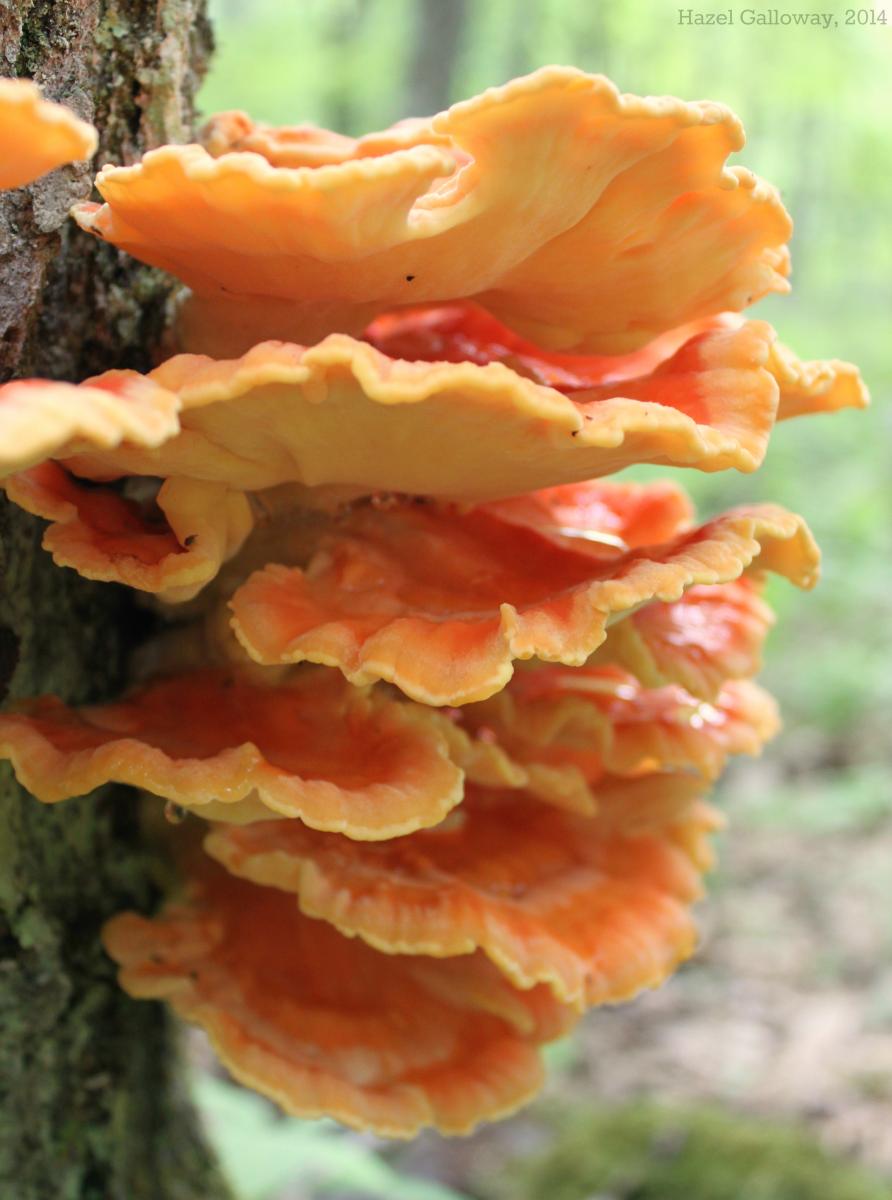Rarely is the name of any species—plant, animal, or fungus—quite so revealing of the use it is put to by humans. But the chicken of the woods is not ill-named; when properly cooked, it can mimic not just the taste but also the texture of chicken and is counted as a delicacy in many dishes. Although it would be remiss not to mention that one should never eat any fungi without being certain of its identity, the chicken of the woods is considered one of the “Foolproof Four” of edible mushrooms (the others being morels, giant puffballs, and shaggy mane). It is distinctive and unmistakable once one is familiar with it, and there are no poisonous species similar enough to be easily confused.
 These fungi grow in large clusters of brackets arranged in a shelving or rosette formation on dead or living oaks, although they may occasionally colonize other host species. The brackets themselves can approach 30 cm across, and are typically fan-shaped to semicircular or irregular. Laetiporus sulphureus’s other common name, ‘sulfur shelf,’ reflects the brilliant hues of the young fungus. The top of the bracket is orange to salmon pink, while the bottom is a sulfur yellow. However, the colors on the bracket fade with age and direct exposure to the sun. The brackets have a delicate suede-like texture and the surface is smooth or finely wrinkled. They have no stem, and typically are found as saprobes (dead matter-feeders) growing directly on decaying trunks. However, in some instances, they can be harmful parasites on living trees.
These fungi grow in large clusters of brackets arranged in a shelving or rosette formation on dead or living oaks, although they may occasionally colonize other host species. The brackets themselves can approach 30 cm across, and are typically fan-shaped to semicircular or irregular. Laetiporus sulphureus’s other common name, ‘sulfur shelf,’ reflects the brilliant hues of the young fungus. The top of the bracket is orange to salmon pink, while the bottom is a sulfur yellow. However, the colors on the bracket fade with age and direct exposure to the sun. The brackets have a delicate suede-like texture and the surface is smooth or finely wrinkled. They have no stem, and typically are found as saprobes (dead matter-feeders) growing directly on decaying trunks. However, in some instances, they can be harmful parasites on living trees.
All chicken of the woods across North America were previously considered a single species, L. sulphureus. However, recent genetic and mating studies have revealed six distinct species, all of which vary slightly in their ecological niche and habitat as well as their genetic compatibility. L. sulphureus is restricted to eastern North American hardwood forests, where it grows on heartwood (and is thus only found at some height up a tree, or at a corresponding location on fallen trees); L. cincinnatus occupies the same habitat but grows at the base of a tree or on the ground nearby. Four other species are distinguishable by their host trees, coloration, growth form, distribution, and taste.
These fungi were collected from a rotting oak log lying near the edge of Route 613 just past the stop sign in the direction of War Spur. Like most fungi, harvesting the brackets does not kill the organism itself, as the brackets are merely fruiting bodies put out by the fungus that lives in the rotting wood. The hyphae (the long, thin strands of cells which make up all fungal bodies) are integrated into the wood. They decompose the organic matter to extract the nutrients necessary to produce the fungal fruiting bodies, which in turn produce haploid spores through meiosis. After being released from the fungus, some of the spores are carried by the wind to settle on another suitable substrate, where they germinate and develop hyphae of their own. However, the fungi are still in the haploid stage of their life cycle and cannot produce fruiting bodies until they encounter hyphae from another haploid individual. When they do, the fungi fuse to become one diploid organism, capable of producing fruiting bodies such as the fine chicken of the woods.
Article by Hazel Galloway
Sources:



